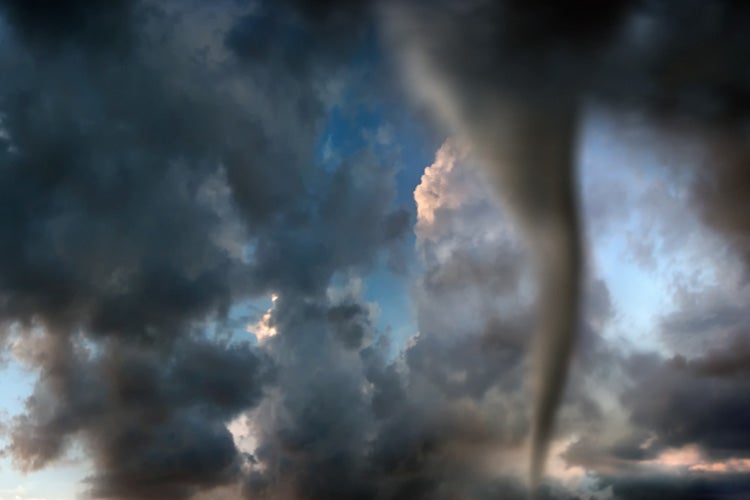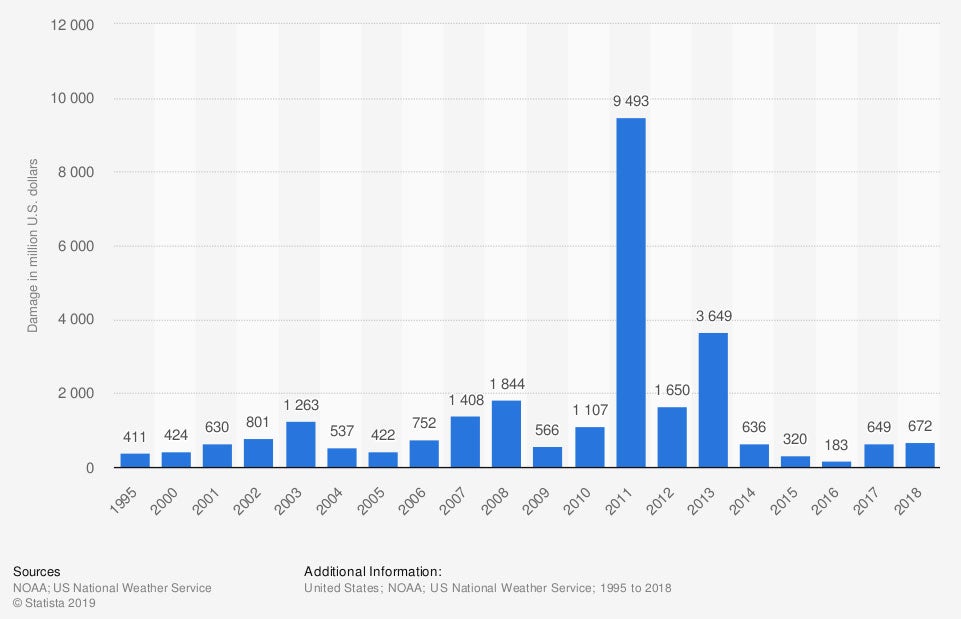
Tornadoes are amongst the most dangerous and unpredictable natural disasters since they can happen anywhere, anytime. Though New Jersey is far from being considered a part of “Tornado Alley,” these storms don’t discriminate. In August of 2019, three tornadoes reportedly touched down in the state within the span of a week, bringing wind gusts of more than 75 MPH with them.
The unpredictable nature of tornadoes makes it important to know how to stay safe no matter where you are when one hits. When disaster strikes, you may not have the luxury of being home and tucked away securely in your safe room. So, long before that stress-inducing storm warning ever pops up on the news, check out this guide to staying safe during a tornado in New Jersey.
Tornado Statistics for New Jersey
New Jersey may be far from Tornado Alley, but it’s still no stranger to tornadoes. Beyond just being a risk for the Garden State, tornadoes are a huge threat to the US as a whole. These funnel-shaped, vicious windstorms cost the country millions of dollars in damages annually, not to mention several tragic deaths. Check out this quick list of tornado stats to better understand why it’s crucial to be prepared for these natural disasters.
Number of tornadoes in the US from 1995 to 2018

More than 1,000 tornadoes were reported across the US each year between 1995 and 2018. The peak year for tornado occurrences was 2004, with a total of 1,819 reported. As of 2018, the storms were still a common threat with 1,154 tornadoes reported that year.
Number of lives lost due to tornadoes in the US from 1995 to 2018

Tornadoes certainly aren’t the deadliest of the natural disasters as far as official death tolls are concerned, but the storms still tragically claim lives every single year. Within the 1995 to 2018 period, 2011 had the peak death toll with 553 lives lost. In 2018, 10 lives were reportedly claimed by tornadoes.
Economic damage caused by tornadoes in the US from 1995 to 2018

Tornadoes are extremely costly when it comes to property and economic damage each year. Tornadoes cost the US millions of dollars in damage annually between 1995 and 2018. Once again the peak year for tornado damage was 2011, with $9.493 billion in destruction reported. However, 2018 still saw a loss of $672 million in damages due to tornadoes.
Before the Tornado in New Jersey: Prepare an Emergency Kit
One of the most commonly recommended safety tips by experts like the Federal Emergency Management Agency (FEMA) and the Red Cross is to prepare an emergency kit to have on hand during natural disasters well in advance. Though tornadoes commonly only last between 10 minutes to an hour, a particularly destructive storm could leave you and your family without power or even stranded for several days.
While emergency kits should include basic essentials that are likely no-brainers for many folks, experts also recommend a few items that may be less obvious. Regardless, the stress of an impending disaster could cause anyone to forget basic necessities.
Grab the following supplies to assemble your emergency kit before the tornado hits:
- Non-perishable food (at least a three-day supply)
- Bottled water (one gallon per person, per day)
- Cellphones and chargers
- Radio
- Battery-powered TV
- Prescription medications and/or inhalers
- Multi-purpose tool
- Flashlight
- Whistle
- Hygiene and sanitation items
- Protective clothing (e.g., gloves, boots, hats, and jackets)
- Pet food and supplies
- Games for children
- Blankets
- Extra batteries
- First aid kit
- Important documents in a safe container
- Cash
- Local maps (in case of evacuation)
Obviously not all of these items will apply to everyone, but you should be able to pick and choose what’s necessary for the safety of your family and yourself.
Before the Tornado in New Jersey Part II: Prepare Your Home and Your Family for Impact
You’ve prepped your emergency kit, but there’s still more work to be done before the storm hits. You may not be able to plan exactly where you’ll be upon impact, so it’s a good idea to prepare both your home and your car. Following these pro tips in advance can help you stay safe during the tornado.
- Designate a safe room: During a tornado, the safest place to wait out the storm is on the lowest level in an interior room away from all exterior doors and windows. Whenever possible, use a basement or detached underground cellar as your safe room for a tornado. Practice having all family members take shelter in your safe room in advance so you’ll be well prepared when a tornado comes.
- Prepare your house: Bring outdoor furniture and other loose objects inside. Secure windows, shutters, and doors, and set your refrigerator and freezer to the coldest settings. Trim potentially hazardous tree/shrub branches to help protect your home from further unnecessary damage. Finally, bring your emergency supply kit into your designated safe room. Note: Mobile homes are not safe places to take shelter in during a tornado. If you live in a mobile home and are aware of an approaching tornado, seek shelter inside a more secure building ASAP.
- Prepare your apartment: Bring any outdoor furniture or other belongings such as planters inside. Install shutters or panels on any sliding glass doors or windows, but note that renters may need to check in with their landlord before making these modifications. Have your emergency kit waiting in your safe room or ready to take with you to a safer location on a lower level. You may want to make arrangements to stay with another tenant in advance.
- Prepare your car: Fill your gas tank in advance in case of emergency evacuation and bring the car into a garage or carport if possible. Double-check all headlights and taillights to make sure they’re working properly and make sure your wiper blades are functional as well. Put local maps and planned emergency evacuation routes inside the glove box ready to grab. Keep your GPS up to date.
You may want to prepare a second emergency kit to keep in your car so you’re not scrambling to find the first one if you’re ordered to evacuate immediately by local authorities.
During the Tornado in New Jersey: Stay Safe, Regardless of Location
Once the storm hits, wherever you are it’s time to put your game face on and take shelter as best you can. Staying safe means different things depending on your location, though. Take these tips to heart for remaining safe during a tornado whether you’re at home, or out, or even on the road.
- Stay safe in your home: Find an interior room in your house or apartment away from external doors and windows to protect yourself from heavy winds. When possible, stay in a basement/cellar or on the lowest level. Take shelter in the center of the room, avoiding corners because they can attract debris buildups. Keep your phone/radio/TV on and stay connected to live updates on the storm’s location as well as orders from your local government so you’ll know ASAP if you’re ordered to evacuate.
- Stay safe inside another building: If you’re at work or in any other building when the tornado hits, follow the same action plan you would if you were home. Take shelter in an interior room on the lowest level. Be sure to avoid cafeterias, auditoriums, large hallways, shopping malls, and gymnasiums due to their flat, wide-span roofs. Break out the cellphone, radio, laptop or TV to stay connected to local New Jersey stations and listen for live storm updates and instructions.
- Take additional cover: Cover your head and neck with your arms to protect yourself from flying or falling objects. If possible, form an additional barricade around yourself and family members using furniture and/or blankets.
- Stay safe inside your car: Never try to outrun a tornado in a vehicle, but if you’re already on the road or ordered to evacuate and there’s a tornado in your area, follow these tips. If you have a passenger or are able to pull over, connect to your state’s Department of Transportation or Office of Emergency Management website to find local evacuation routes. Do your best to avoid bridges. Be aware that stop lights may have lost power, so check your surroundings twice before driving through intersections. You can also locate New Jersey emergency shelters in your area through FEMA’s mobile app. If the tornado is very close to you, pull over and seek shelter in a ditch or other area that’s lower than the road, and cover your head with your arms. If you’re trapped in your car and see flying debris, keep your head below window level and cover up with a blanket.
Regardless of where you are, your best chance at remaining safe during a tornado, aside from keeping your emergency kit close, is to stay connected to local, live updates. If you’re ordered to evacuate, don’t hesitate to get moving.
After the Tornado in New Jersey: Stay Cautious
After the storm passes, hazardous conditions may still be present. If you’ve evacuated, stay put until otherwise instructed by local officials. Otherwise, follow these action steps to keep safe once the tornado has left the area:
- Stay connected to live updates: Even after the tornado has passed, it’s still important to stay connected to local New Jersey stations for updates for further instructions.
- If trapped, signal for help: It’s important to keep your nose and mouth covered to avoid inhaling debris if you’re trapped after the tornado. Use your phone or laptop to send emergency messages, or create loud noise by banging against furniture, walls, or pipes to signal to outside help. Avoid speaking/yelling as much as possible.
- Be aware of your surroundings: As you move from your current location to another following the tornado, be aware of potential dangers like fallen power lines or unstable objects that have been thrown and stacked by tornado winds.
- Avoid entering other buildings: Try not to enter another location until it’s been inspected. Electrical systems, gas lines, septic and plumbing systems may have been damaged during the tornado and can present dangerous conditions.
- Put on safety gear: Suit up in your boots or heavy-duty shoes, pants, and rubber gloves following the storm. Grab a cloth or mask to cover your mouth and nose to avoid breathing in irritants if your area was hit hard by the tornado. Storms can stir up potentially dangerous airborne debris like mold and dust. You may also have animals, pests, or strangers in your home to watch out for.
- Toss any contaminated food: Food that may have perished due to power outages or has otherwise been compromised by the storm damage should be tossed. Also be sure to wait until the “OK” is given from local officials before using tap water, though you may choose to boil or otherwise purify it for use in the meantime.
- Perform a deep clean: All surfaces that got dusty or dirty from the tornado should be cleaned and disinfected ASAP.
Finally, you may wish to connect with any friends, family, or other emergency contacts outside of your area to update them on your status after the tornado has passed. If your home has become unlivable, you might also want to make temporary lodging arrangements with your emergency contacts.
Author | Chris Lacagnina
Article Reviewed by | Paul Martin
fema.gov
spc.noaa.gov
ready.gov
osha.gov
redcross.org
© 2024, Consumer Agent Portal, LLC. All rights reserved.